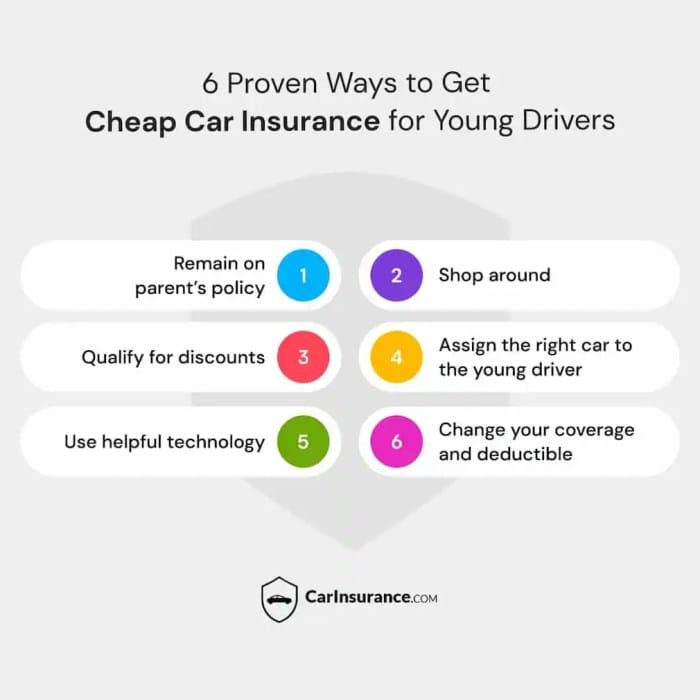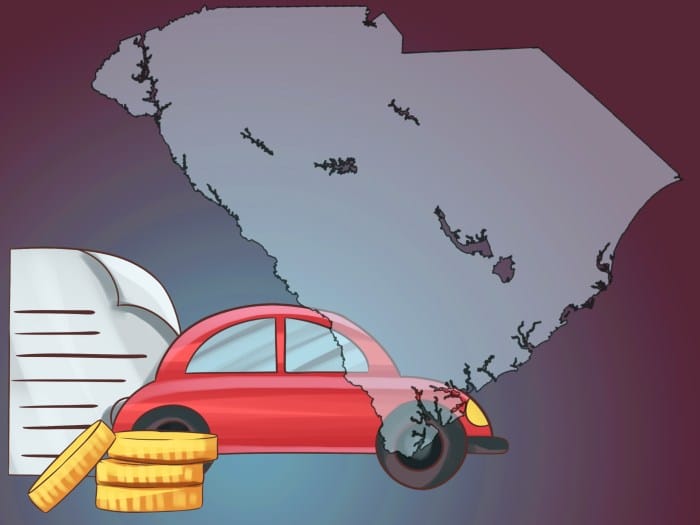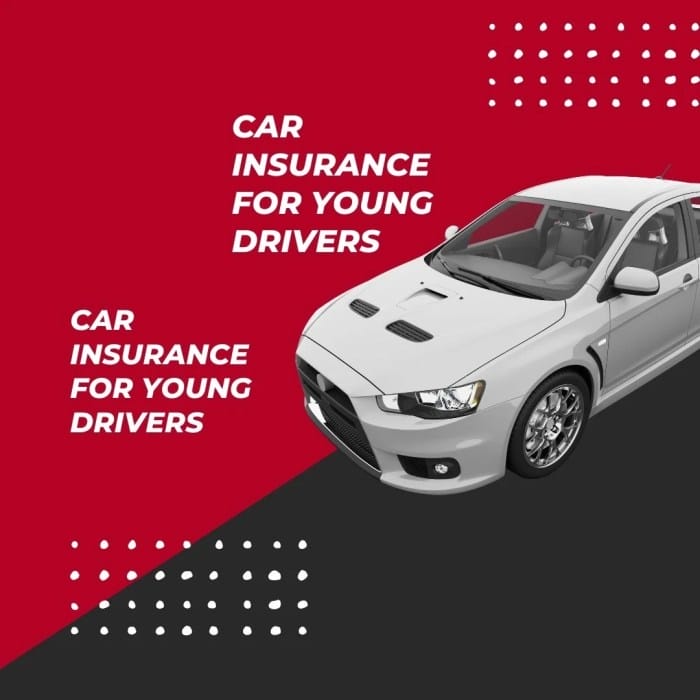In the realm of automotive adventures, young drivers often face a daunting challenge: securing affordable car insurance. Insurance companies, wary of their perceived risk, frequently impose higher premiums on these inexperienced road warriors. Yet, there’s hope for budget-conscious young drivers.
By embracing safe driving practices, exploring discounts, and utilizing innovative insurance programs, they can navigate the insurance landscape and find policies that won’t break the bank.
Navigating the world of car insurance as a young driver can be a daunting task. However, by adopting responsible driving habits, seeking out discounts, and exploring innovative insurance options, young drivers can find affordable coverage that meets their needs and protects their financial well-being.
Young Drivers’ Insurance Premiums

Insurance companies charge higher premiums for young drivers due to the increased risk associated with their driving habits and experience. Young drivers are statistically more likely to be involved in accidents, and these accidents tend to be more severe.
There are several factors that contribute to the increased risk associated with young drivers. These factors include:
Inexperience
Young drivers have less experience behind the wheel, which can lead to poor decision-making and risky driving behaviors. They may be more likely to speed, drive under the influence of alcohol or drugs, or engage in other dangerous activities while driving.
Immaturity
Young drivers may also be more impulsive and less likely to think through the consequences of their actions. They may be more likely to take risks, such as driving too fast or following too closely, which can increase the risk of an accident.
Peer pressure
Young drivers may also be more likely to engage in risky driving behaviors in order to impress their friends or peers. They may be more likely to speed, drive recklessly, or show off their driving skills, which can increase the risk of an accident.
Lack of awareness
Young drivers may also be less aware of the dangers of driving and the risks involved. They may not be as familiar with the rules of the road or the hazards that they may encounter while driving, which can increase the risk of an accident.
Safe Driving Practices

Engaging in safe driving practices is crucial for young drivers to lower their insurance premiums. Insurance companies assess the risk associated with insuring a driver based on their driving history and behavior. By demonstrating safe and responsible driving habits, young drivers can reduce the likelihood of accidents and claims, resulting in lower insurance costs.
Here are some specific safe driving behaviors that can help young drivers lower their insurance premiums:
Defensive Driving
Practicing defensive driving techniques involves anticipating potential hazards and taking steps to avoid them. This includes maintaining a safe following distance, scanning the road ahead for potential dangers, and being aware of other drivers’ actions. Defensive driving can help young drivers avoid accidents and reduce their risk of being involved in a collision.
Speed Limit Adherence
Young drivers who consistently obey speed limits and avoid speeding tickets demonstrate responsible driving behavior. Speeding is a major contributing factor to accidents, and insurance companies view drivers who speed as higher-risk individuals. By adhering to speed limits, young drivers can reduce their chances of getting into an accident and lower their insurance premiums.
Avoiding Distractions
Eliminating distractions while driving is essential for young drivers to maintain focus and control. This includes avoiding the use of cell phones, texting, eating, or engaging in other activities that take their attention away from the road. Distracted driving significantly increases the risk of accidents, and insurance companies view distracted drivers as higher-risk individuals.
Seat Belt Usage
Always wearing a seat belt is a fundamental safety practice that can save lives in the event of an accident. Insurance companies recognize the importance of seat belt usage and may offer lower premiums to drivers who consistently buckle up.
Wearing a seat belt demonstrates responsible driving behavior and reduces the severity of injuries in the event of a collision.
Accident-Free Driving History
Maintaining an accident-free driving history is the most effective way for young drivers to lower their insurance premiums. Insurance companies consider drivers with a clean driving record to be lower-risk individuals and reward them with lower premiums. By avoiding accidents and traffic violations, young drivers can demonstrate their responsible driving behavior and secure lower insurance costs.
Defensive Driving Courses

Taking defensive driving courses is a smart move for young drivers who want to improve their driving skills, reduce their risk of accidents, and save money on car insurance.
Defensive driving courses teach young drivers how to anticipate and avoid hazards, how to react safely to dangerous situations, and how to drive defensively in all types of conditions.
Course Types and Impact on Insurance Rates
There are two main types of defensive driving courses: online courses and in-person courses.
- Online courses are typically less expensive than in-person courses, but they may not be as comprehensive. They usually take about 6-8 hours to complete and can be done at your own pace.
- In-person courses are typically more expensive than online courses, but they offer more hands-on instruction and feedback. They usually take about 8-10 hours to complete and are taught by certified driving instructors.
Both online and in-person defensive driving courses can help young drivers save money on car insurance. Some insurance companies offer discounts to drivers who complete a defensive driving course, typically ranging from 5% to 15%.
Maintaining a Clean Driving Record

Maintaining a clean driving record is paramount for young drivers seeking affordable insurance rates. A spotless record demonstrates responsibility and adherence to traffic laws, making you a less risky prospect for insurers. Conversely, a blemished record, marred by traffic violations or accidents, signals a higher likelihood of future claims, leading to elevated premiums.
Avoiding Traffic Violations
A clean driving record begins with avoiding traffic violations. Obey speed limits, come to complete stops at stop signs, and yield to pedestrians and other vehicles. Avoid distractions like cell phones or excessive noise, and never drive under the influence of alcohol or drugs.
Avoiding Accidents
Accidents are more than just costly; they can also tarnish your driving record. Practice defensive driving techniques, such as maintaining a safe following distance, being aware of blind spots, and anticipating the actions of other drivers. Drive defensively, not aggressively, and always be prepared for the unexpected.
Bundling Policies

Bundling insurance policies is a strategic approach that involves combining multiple insurance coverages under a single insurance provider. This practice offers several potential benefits for young drivers seeking affordable car insurance.
Bundling policies can result in significant cost savings. Insurance companies often provide discounts when customers purchase multiple policies from them. These discounts can vary depending on the insurance provider and the specific policies being bundled, but they can be substantial, potentially leading to hundreds of dollars in savings annually.
Convenience and Streamlined Management
Bundling policies also enhances convenience and streamlines insurance management. By having all your insurance policies under one roof, you only need to deal with a single insurance company for all your insurance needs. This simplifies the process of paying premiums, filing claims, and managing your policies.
Additionally, it reduces the risk of coverage gaps or overlaps, ensuring that you have comprehensive protection without any gaps.
Commonly Bundled Policies
There are various types of insurance policies that can be bundled together for savings. Some common examples include:
- Car insurance and homeowners or renters insurance
- Car insurance and motorcycle insurance
- Car insurance and boat insurance
- Car insurance and travel insurance
- Car insurance and life insurance
The specific policies available for bundling may vary depending on the insurance company. It is important to compare quotes from different insurance providers to find the best deal on bundled policies.
Loyalty Discounts
Loyalty discounts reward young drivers who maintain a relationship with the same insurance company for an extended period. By demonstrating responsible driving behavior and maintaining a clean driving record, young drivers can earn discounts that can significantly lower their insurance premiums.
The criteria for qualifying for loyalty discounts vary among insurance companies. Generally, young drivers must maintain a policy with the same company for a specified number of years, typically three to five years. Some insurers may also require young drivers to maintain a clean driving record during that time.
The potential savings offered by loyalty discounts can vary, but they can be substantial, often ranging from 5% to 15% off the base premium.
Continuous Coverage
Maintaining continuous coverage is essential for qualifying for loyalty discounts. Lapses in coverage, even for short periods, can reset the loyalty discount clock. Young drivers should ensure they maintain uninterrupted coverage to maximize their savings.
Bundling Policies
Bundling multiple insurance policies with the same company can further enhance the loyalty discount. Young drivers who bundle their car insurance with other policies, such as renters or homeowners insurance, may be eligible for additional discounts.
Usage-Based Insurance

Usage-based insurance (UBI) programs offer young drivers a unique opportunity to potentially save money on their car insurance premiums by tracking their driving behavior and rewarding them for safe driving habits. Telematics devices installed in their vehicles collect data on various driving parameters, which insurance companies use to determine their insurance rates.
UBI programs typically involve installing a telematics device in the young driver’s vehicle. This device tracks driving behavior, such as speed, braking, acceleration, and mileage, and sends the data to the insurance company. The insurance company uses this data to assess the driver’s risk level and determine their insurance rate.
Benefits of Usage-Based Insurance for Young Drivers
- Lower Insurance Premiums: Young drivers with good driving habits may qualify for lower insurance rates under UBI programs compared to traditional insurance policies.
- Personalized Rates: UBI programs allow insurance companies to tailor insurance rates to the individual driving behavior of young drivers, rather than relying solely on age and other general factors.
- Feedback and Coaching: Some UBI programs provide feedback to young drivers on their driving habits, helping them identify areas for improvement and potentially reducing their insurance rates over time.
Raising the Deductible
Raising the deductible on your car insurance policy is a way to lower your insurance costs. A deductible is the amount you pay out of pocket before your insurance coverage kicks in. The higher the deductible, the lower your insurance premium will be.
Impact of Raising the Deductible
The amount you can save by raising your deductible will vary depending on your insurance company, the type of coverage you have, and your driving history. In general, you can expect to save around $100 per year for every $100 you increase your deductible.
For example, if you raise your deductible from $500 to $1,000, you could save around $50 per year on your insurance premium.
Shopping Around for Quotes

To secure the most favorable car insurance rates as a young driver, it is essential to meticulously compare quotes from multiple insurance providers. This comprehensive comparison process not only enables you to identify the most cost-effective options but also allows you to assess the coverage and terms offered by different insurers.
To obtain accurate quotes, it is crucial to provide consistent and accurate information to each insurance company. This includes details such as your age, driving history, vehicle information, and desired coverage level. Additionally, be prepared to furnish proof of a clean driving record and any relevant discounts or qualifications that may apply.
Evaluate Insurance Policies
When evaluating insurance policies, consider the following factors:
- Coverage Limits: Ensure that the policy provides adequate coverage for your vehicle and liability in the event of an accident.
- Deductible: Understand the deductible amount and how it affects your premium and out-of-pocket expenses.
- Discounts: Inquire about available discounts, such as those for good grades, safe driving courses, or multiple vehicles insured under the same policy.
- Customer Service: Research the reputation and customer service ratings of the insurance company to gauge their responsiveness and support.
Consider Usage-Based Insurance

Usage-based insurance (UBI) programs are gaining popularity among young drivers as a way to save money on car insurance. UBI programs track driving behavior and adjust premiums accordingly, rewarding safe drivers with lower rates.
Technology Involved in Usage-Based Insurance
UBI programs use a variety of technologies to track driving behavior, including GPS, accelerometers, and gyroscopes. These devices collect data on factors such as speed, braking, acceleration, and cornering. This data is then used to calculate a driver’s risk profile and determine their insurance premium.
Benefits of Usage-Based Insurance for Young Drivers
UBI programs can offer several benefits to young drivers, including:
- Lower insurance premiums: Safe drivers can save money on their car insurance premiums by participating in a UBI program.
- Personalized feedback: UBI programs provide drivers with personalized feedback on their driving habits, which can help them improve their driving skills and reduce their risk of accidents.
- Discounts for safe driving: Some UBI programs offer discounts for safe driving, such as maintaining a clean driving record or taking a defensive driving course.
Final Summary
In the dynamic world of car insurance, young drivers hold the key to unlocking affordable coverage. Through safe driving practices, defensive driving courses, and clean driving records, they can demonstrate their commitment to responsible driving and reap the rewards of lower premiums.
Bundling policies, seeking loyalty discounts, and considering usage-based insurance further enhance their savings potential. By embracing these strategies, young drivers can embark on their automotive journeys with peace of mind, knowing they’ve secured insurance that fits their budget and safeguards their financial future.
FAQ
Q: Why do insurance companies charge higher premiums for young drivers?
A: Young drivers are perceived as higher-risk drivers due to their limited experience, higher likelihood of accidents, and tendency to engage in risky driving behaviors.
Q: What safe driving practices can lower insurance premiums for young drivers?
A: Maintaining a clean driving record, obeying speed limits, avoiding distractions, and practicing defensive driving techniques can positively impact insurance rates.
Q: How can defensive driving courses benefit young drivers in terms of insurance savings?
A: Defensive driving courses teach young drivers safe driving techniques and strategies to avoid accidents, which can lead to lower insurance premiums.
Q: What is usage-based insurance, and how can it save young drivers money?
A: Usage-based insurance programs track driving behavior through telematics devices and offer lower rates to drivers who demonstrate safe driving habits.



